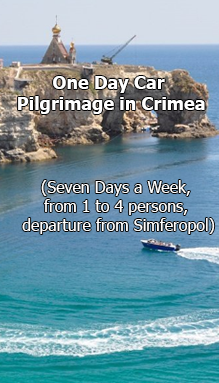Simferopol
Simferopol is the administrative, industrial and cultural centre of the Crimea. It is situated on the banks of the Salghir River. The population of Simferopol is 344,000 people.
In the 4th century it was the capital of the Scythians Kingdom, Scythian Neapolis. In the 16th century there was a Tartar settlement of Ak-Mesdzhid (White Mosque), the residence of the Crimean Khan’s heir. The city of Simferopol was founded in 1784. It was called Simferopol — the City-Gatherer. On its City Coat of Arms there is a bee on the honeycomb. Simferopol has many monuments of culture and architecture.
The oldest building of Simferopol is the mosque Kebir-Dzhami. It was built in 1508.
The Vorontsov Palace stands in a park on the bank of the Salghir. The architect F. Elson built the palace in 1826. The building in the Empire style has exotic forms of Moslem architecture. The mansion of Dinzer with an asymmetric composition has Baroque forms.
The Ivan Franko Library is situated in the building built in 1826. During the Crimean war it was a hospital where N. Pirogov saved many lives.
The building of the old gymnasium is a unique memorial monument. Here many famous people worked: D. Mendeleyev, the Karaite poet Ilya Kazas. The students of the gymnasium were I. Kurchatov, the Armenian composer Spendiarov, I. Aivazovskiy and Ismail Gasprinskiy.
The Russian Theatre of Drama is the oldest in the Crimea. It was built it in 1911. The architect A. Beketov used forms of Art Nouveau and antique architecture. The artist I. Suvorov decorated the interior. Many outstanding actors and musicians like F. G. Ranevskaya and I. O. Dunayevsky worked here. The outstanding American tragic and friend of T. Shevchenko Ira Aldridge played Othelo. During the Great Patriotic War the Sokol (Falcon) underground group was active here.
The railway station of Simferopol with a high clock tower has features of the Italian Renaissance. It is marked by the harmonious proportions and monumentality. It was built by the architect A. Dushkin in 1952.
The building of the Crimean Ukrainian Theatre of Drama and Musical Comedy was built in 1977. It has asymmetrical composition and huge glass panels with monumental galleries. The theatre began to function in 1955. Its repertoire includes, classical Ukrainian plays “Zaporozhzhian Cossack Beyond the Danube”, “Matchmaking in Honcharovka” etc.
There are many historical monuments and memorials in the capital of the Crimea. There is an 18-metre high obelisk to the Russian Army which liberated Crimea from the Turks — 1771. It bears a bas-relief portrait of the Commander of the Army, V. M. Dolgorukov. The monument to A. V. Suvorov (1730–1800) stands on the place of the former camp of Russia troops. Its pedestal looks like a bastion. A statue of A. V. Suvorov rises on a small rock. There is the monument to A. Pushkin who visited Simferopol in September 1820. Many outstanding people lived and worked in Simferopol. Among them were A. Griboyedov and Lev Tolstoy. The capital of the Crimea is the home of Tauris National University and more then ten institutions. The first Ukrainian Academician V. Vernadskiy lectured in Tauris University. In Simferopol there are two museums.
The holy places of Simferopol are the Central Peter’s and Paul’s Cathedral, where there are the relics of the Sainted Hierarch Gurias (G. P. Karpov) — the Archbishop of Taurida, the Holy Trinity Convent, where there the relics of the Sainted Hierarch Luke (V. F. Voino-Yasenetskiy), an outstanding theologian, professor of medicine, the active temples of: Sts. Constantine and Helen, Three Sainted Hierarchs, All Saints, and also the Alexander Nevski Cathedral being restored now.












